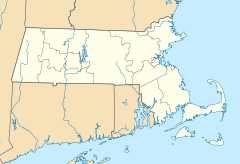- Moswetuset Hummock
-
Moswetuset Hummock
 Moswetuset Hummock as seen from Quincy Shore Drive
Moswetuset Hummock as seen from Quincy Shore DriveLocation: E. Squantum Street, near jct. with Quincy Shore Drive, Quincy, Massachusetts Coordinates: 42°17′22″N 71°1′16″W / 42.28944°N 71.02111°WCoordinates: 42°17′22″N 71°1′16″W / 42.28944°N 71.02111°W Built: 1600 Governing body: State NRHP Reference#: 70000094 Added to NRHP: July 01, 1970 Moswetuset Hummock is a wooded historic place in Quincy, Massachusetts. It was added to the National Register of Historic Places in 1970.[1]
The site is located at the northern end of Wollaston Beach along Quincy Bay on East Squantum Street near the junction with Quincy Shore Drive. It was the seat of the ruling American Indian chief Chickatawbut, who was visited by Plymouth Colony commander Myles Standish and Squanto, a native guide, in 1621. Moswetuset means "shaped like an arrowhead". In his 1747 volume A History of New-England historian Daniel Neal described Moswetuset Hummock as the origin of the name of the indigenous Massachusett tribe, and thus the name of the Commonwealth of Massachusetts:[2][3]
The Sachem or Sagamore who governed the Indians in this part of the country when the English came hither, had his seat on a small hill, or hummock, containing perhaps an acre and a half, about two leagues to the southward of Boston, which hill or hummock lies in the shape of an Indian's arrowhead, which arrow-heads are called in their language MOS, or MONS, with O nasal, and hill in their language is WETUSET hence, this great sachem's seat was called Moswetuset, which signifies a hill in the shape of an arrow's head, and his subjects, the Moswetuset Indians, from whence with a small variation of the word, the Province received the name MASSACHUSETTS.
Hummock is a geological term for a small knoll or mound.[4]
Notes and references
- ^ "National Register Information System". National Register of Historic Places. National Park Service. 2008-04-15. http://nrhp.focus.nps.gov/natreg/docs/All_Data.html.
- ^ "East Squantum Street (Moswetuset Hummock)". Quincy, Mass. Historical and Architectural Survey. Thomas Crane Public Library. 1986. http://thomascranelibrary.org/htm/436.htm. Retrieved 2009-06-24.
- ^ Neal, Daniel (1747). "XIV: The Present State of New England". The history of New-England. 2 (2 ed.). London: Printed for A. Ward. pp. 216. OCLC 8616817. http://books.google.com/books?id=u3opAAAAYAAJ&pg=PA216. Retrieved 2009-06-24.
- ^ Bates, Robert L. and Julia A. Jackson, ed. (1984). “hummock.” Dictionary of Geological Terms, 3rd Ed. New York: Anchor Books. p. 241.
External links
- Discover Quincy: Attractions
- Quincy Shores Reservation (Massachusetts Department of Conservation and Recreation)
U.S. National Register of Historic Places Topics Lists by states Alabama • Alaska • Arizona • Arkansas • California • Colorado • Connecticut • Delaware • Florida • Georgia • Hawaii • Idaho • Illinois • Indiana • Iowa • Kansas • Kentucky • Louisiana • Maine • Maryland • Massachusetts • Michigan • Minnesota • Mississippi • Missouri • Montana • Nebraska • Nevada • New Hampshire • New Jersey • New Mexico • New York • North Carolina • North Dakota • Ohio • Oklahoma • Oregon • Pennsylvania • Rhode Island • South Carolina • South Dakota • Tennessee • Texas • Utah • Vermont • Virginia • Washington • West Virginia • Wisconsin • WyomingLists by territories Lists by associated states Other  Category:National Register of Historic Places •
Category:National Register of Historic Places •  Portal:National Register of Historic Places
Portal:National Register of Historic PlacesThis article about a National Register of Historic Places listing in Norfolk County, Massachusetts is a stub. You can help Wikipedia by expanding it.

